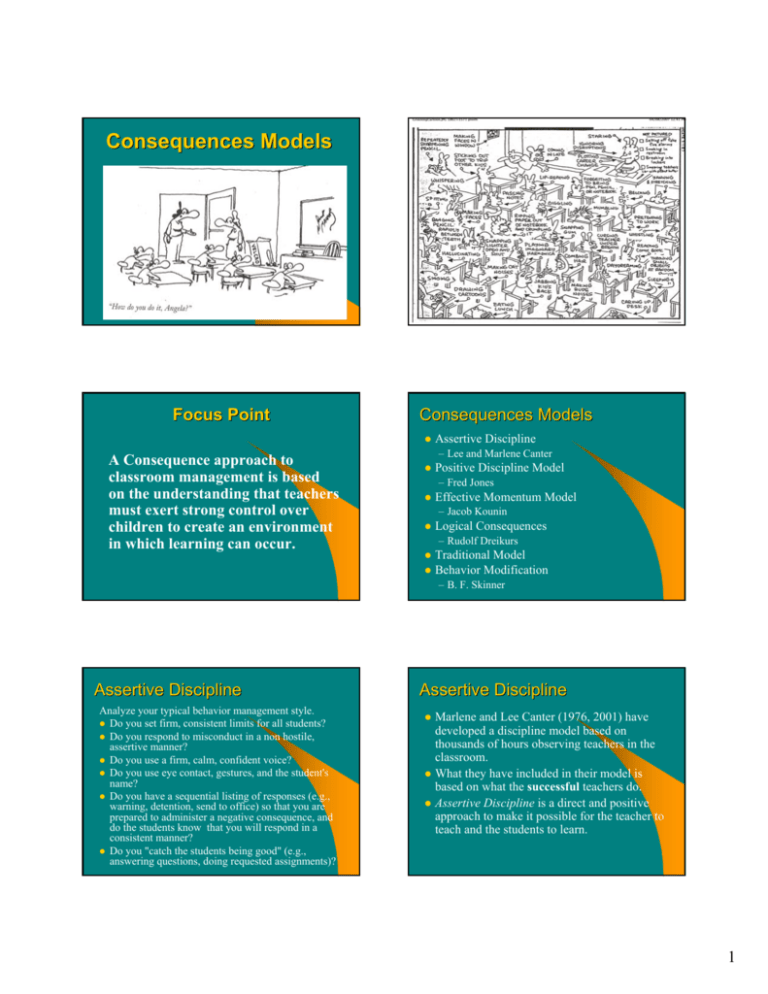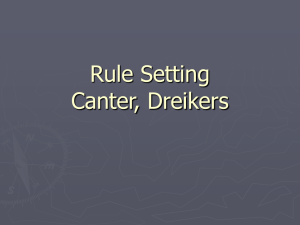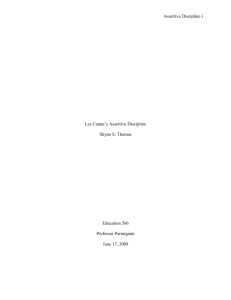Chapter 5 Consequences Models
advertisement

Consequences Models Focus Point A Consequence approach to classroom management is based on the understanding that teachers must exert strong control over children to create an environment in which learning can occur. Consequences Models z Assertive Discipline z Positive Discipline Model z Effective Momentum Model z Logical Consequences – Lee and Marlene Canter – Fred Jones – Jacob Kounin – Rudolf Dreikurs Traditional Model z Behavior Modification z – B. F. Skinner Assertive Discipline Analyze your typical behavior management style. z Do you set firm, consistent limits for all students? z Do you respond to misconduct in a non hostile, assertive manner? z Do you use a firm, calm, confident voice? z Do you use eye contact, gestures, and the student's name? z Do you have a sequential listing of responses (e.g., warning, detention, send to office) so that you are prepared to administer a negative consequence, and do the students know that you will respond in a consistent manner? z Do you "catch the students being good" (e.g., answering questions, doing requested assignments)? Assertive Discipline Marlene and Lee Canter (1976, 2001) have developed a discipline model based on thousands of hours observing teachers in the classroom. z What they have included in their model is based on what the successful teachers do. z Assertive Discipline is a direct and positive approach to make it possible for the teacher to teach and the students to learn. z 1 Assertive Discipline Most Teacher Control Authoritarian Management Style z Teacher is, at all times, attentive to what is in the best interests of the students. z Teachers’ rights include establishing an optimal learning environment and expecting appropriate behavior from students. z Students’ rights include a safe and productive learning environment. Assertive Discipline z z z z – Code of Ethics Assertive Discipline Five Basic Procedures 1. 2. 3. 4. 5. Determine negative consequences for noncompliance and positive consequences for appropriate behaviors. Identify your expectations • Draw a clear line between appropriate and inappropriate behaviors. Stress why positive behavior is necessary. Persist in reinforcing expectations using a firm tone of voice and maintaining eye contact • Use nonverbal gestures to clearly convey intentions. Be assertive in confrontations with students over behavior, reminding them of expectations and consequences without hostility or threats. • Make sure the established consequences are consistently enforced. Assertive Discipline Weaknesses z z z z z z Power inequity – students are not invited into the management process. Rules are nonnegotiable. Students are punished or rewarded depending on their ability to conform to the rules established by the teacher. Goal of self-discipline is secondary to the models aims. – Control is externally imposed on students. Fails to deal with the underlying causes of discipline problems. Extreme misbehavior results in student suspension. z z z z z Teachers insist on proper behavior from students. Teachers set clear limits and determine consequences. Teachers respond to misbehavior in a calm, firm manner. Teachers recognize and support students when they practice appropriate behaviors. Teachers use well-organized procedures for following through when students do not behave. Negative consequences are consistently given out for rule infractions. Teachers use positive reinforcements, rewards and praise to encourage good behavior. Assertive Discipline Strengths z Simple to use and straightforward z Teachers have the power –this gives them a feeling of security and instills a sense of confidence in their abilities. z Involves parents and administration in the discipline process – TEAM WORK z Expectations are clear. z Consequences are consistently applied. Examples z HILLSBOROUGH COUNTY PUBLIC SCHOOLS TRANSPORTATION DEPARTMENT – http://www.sdhc.k12.fl.us/transportation/assertived iscipline.asp z USD of Cherokee, Kansas - Weir Assertive Discipline Policy – http://www.usd247.com/vnews/display.v/SEC/Wei r%20Attendance%20Center%3E%3EDiscipline%2 0Policy 2 Weblinks Resources z http://wik.ed.uiuc.edu/index.php/Assertive_disc ipline z http://wik.ed.uiuc.edu/index.php/Canter,_Lee z http://maxweber.hunter.cuny.edu/pub/eres/EDS PC715_MCINTYRE/AssertiveDiscipline.html z z z z z z Positive Discipline z z Fredric Jones (1987) The use of proximity and physical presence Lee & Marlene Canter. (1993). Succeeding with difficult students: New strategies for reaching your most challenging students. Santa Monica, CA: Canter and Associates. Lee & Marlene Canter. (1992). Assertive discipline: Positive behavior management for today's classroom. Santa Monica, CA: Canter and Associates. Lee Canter. (1979). Discipline: You can do it! Instructor, 89(2), 106-112. Lee & Marlene Canter (1976, 1982). Assertive discipline: A take-charge approach for today's educator. Los Angeles: Canter and Associates. Lee and Marlene Canter (1982). Assertive discipline for parents. Los Angeles: Canter and Associates. Mandlebaum, L. H., Russell, S. C., Krouse, J., & Ganter, M. (1983). Assertive discipline: An effective classroom behavior management program. Behavioral Disorders, 8(4), 258-264. Positive Discipline Model z Weblinks – Canter and Jones Models z http://www.humboldt.edu/~tha1/canter.html – http://www.fredjones.com/ – http://wik.ed.uiuc.edu/index.php/Positive_Di scipline – http://faculty.msmc.edu/frm6763/pdf/positive _discipline.pdf Effective Momentum Model z z Jacob Kounin (1977) – http://wik.ed.uiuc.edu/index.php/Kounin,_Jacob With-it-ness – http://karolyeatts.com/Classroom%20Manageme nt/Withitness.pdf – http://www.pecentral.org/climate/april99article.ht ml – http://www.educ.uvic.ca/epls/faculty/rowles/koun in1.htm Logical Consequences Social Discipline Model z z Rudolf Dreikurs – http://wik.ed.uiuc.edu/index.php/Dreikurs,_Rudolf – http://en.wikibooks.org/wiki/Classroom_Manageme nt_Theorist_and_Theories/Rudolf_Dreikurs This model is based on the assumption that inappropriate behavior is motivated by the desire to gain attention, exercise power, exact revenge, or display inadequacy – http://www.disciplinehelp.com/teacher/ 3 Traditional Model Traditional or Instructional-eclectic (cookbook approach) z Most-teacher-control approach z Reactive rather than proactive approach z Uses positive reinforcement, rewards, honor rolls, special privileges for well-performing students. z Figure 4.2 page 57 z Journal Response #3 z How can you justify the use of behavior modification in a democratic society? – Provide examples IOSIE Case Study z Assertive Discipline Behavior Modification z – "The consequences of behavior determine the probability that the behavior will occur again“ http://wik.ed.uiuc.edu/index.php/Skinner,_B._F. z http://wik.ed.uiuc.edu/index.php/Behavior_Anal ysis z http://www.behavior.org/ z http://www.cabas.com/homepage.html z True and False Discipline according to Jones is creating time on task in the most unobtrusive fashion. 2. The main strength of the neo-Skinnerian model is that behavior modification works. 3. Many traditional approaches use behavior modification. 4. Teachers who rely on the traditional model tend to enforce rules after critically analyzing each situation. 5. Behavior modification advances the theory that discipline is not punishment; it is an attempt to instill in students self-control. 6. Canter believes that maintaining momentum in the classroom is key to successful teaching. 7. The Jones model draws theoretically and conceptually from the knowledge base of behavior modification. 8. Jones believes that teachers should offer incentives, such as “preferred activity time to keep students on task. 9. Assertive discipline uses negative and positive consequences rather than to logical consequences as recommended by Dreikurs. 10. All teachers use behavior modification to some extent, but few do so systematically, as advocated by Bandura. 1. Code of EthicsEthics-Cases from the Field z – 2, 7, 19 z Jones Model z The Kounin Effective Momentum Model z Logical Consequences z Traditional Model – 3, 15, 22 – 11, 18, 25, 26 z z – 1, 15, 19 – 8, 12, 22 z Behavior Modification – 1, 9, 10 B. F. Skinner z z Students will write a paper that compares their responses to those of a practicing teacher about approaches that would be used when confronted with the situations found on pages 22-23 in the Scarpaci text. Students must include their personal response to the importance of having and adhering to a code of ethics. The paper must also include how the responses (student and interviewee) adhere to the Code of Ethics and Principles of Professional Conduct of the Education Profession in Florida. NOTE: Be sure to relate the responses to the specific components of the Code of Ethics. The ethics assignment will be assessed using the attached Adhering to the Code of Ethics Scoring Criteria. 4






